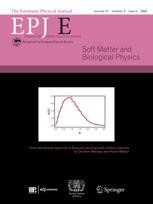Modelling the behaviour and dynamics of microswimmers
The understanding of the clustering and movement of microswimmers has a range of applications from human health to tackling ecological problems.
New York | Heidelberg, 24 May 2022
 Microswimmers are biological entities that range from sperm to phytoplankton to bacteria, meaning that their study can have implications for fields in science as diverse as human health and ecology.
Microswimmers are biological entities that range from sperm to phytoplankton to bacteria, meaning that their study can have implications for fields in science as diverse as human health and ecology.
A new paper published in EPJ E looks at the dynamics of microswimmers under gravity. It is authored by a team from the Institute for Theoretical Physics at the Berlin Institute of Technology: Felix Rühle, Arne W. Zantop, and Holger Stark.
“My supervisor Professor Holger Stark and our team have long been interested in the collective behaviour of microswimmers,” Rühle says. “Within this field, patterns formed by biological organisms, such as algae and bacteria, are known as bioconvection.”
As an example, Rühle points to algal patches in the ocean which can be an ecological problem.
The team focus on squirmers — a model for a spherical microswimmer swimming in Stokes flow — to identify different dynamical states for such systems.
“For this project, we were interested in a specific kind of pattern formation that happens under gravity — swimmers reorient each other mediated by the flow field they create in the fluid,” Rühle continues. “But, at the same time, they have a tendency to point upwards — anti-parallel to gravity. The motion directed by a combination of these effects is called gyrotaxis, and we show how and when clusters form under these conditions in numerical simulations.”
While bioconvection can have many possible causes, such as the diffusion of oxygen, access to sunlight or turbulent flows, Rühle explains that the team’s simulations show that two “ingredients” are sufficient for clusters to form. These are gravity and hydrodynamic interactions with the strength of the reorienting gravity torque — which arises due to the centre of mass being below the geometrical centre , controlling the size of the clusters.
“This insight furthers our understanding of biological patterns in general,” Rühle concludes.
References: Rühle, F., Zantop, A.W. & Stark, H. Gyrotactic cluster formation of bottom-heavy squirmers., Eur. Phys. J. E 45, 26 (2022). https://doi.org/10.1140/epje/s10189-022-00183-5
Further Information
For more information visit: www.epj.org
Services for Journalists
The full-text article is available here.
Contact
Sabine Lehr | Springer | Physics Editorial Department
tel +49-6221-487-8336 | sabine.lehr@springer.com
